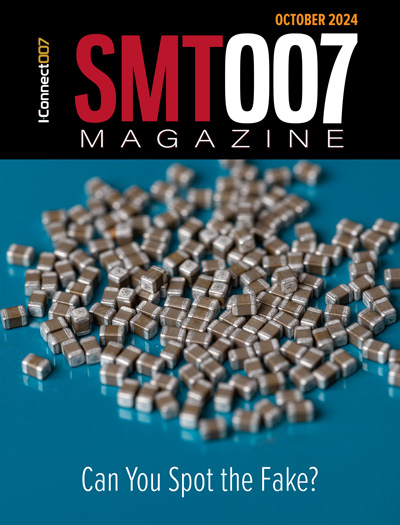-

- News
- Books
Featured Books
- smt007 Magazine
Latest Issues
Current Issue
The Rise of Data
Analytics is a given in this industry, but the threshold is changing. If you think you're too small to invest in analytics, you may need to reconsider. So how do you do analytics better? What are the new tools, and how do you get started?

Counterfeit Concerns
The distribution of counterfeit parts has become much more sophisticated in the past decade, and there's no reason to believe that trend is going to be stopping any time soon. What might crop up in the near future?

Solder Printing
In this issue, we turn a discerning eye to solder paste printing. As apertures shrink, and the requirement for multiple thicknesses of paste on the same board becomes more commonplace, consistently and accurately applying paste becomes ever more challenging.
- Articles
- Columns
Search Console
- Links
- Media kit
||| MENU - smt007 Magazine
Untapped Potential: Automating Warehouse Management Into the Present
October 15, 2024 | Josh Casper, Horizon SalesEstimated reading time: 2 minutes
The push toward automation in electronics manufacturing has led to significant improvements in SMT and through-hole technology (THT) production. Today’s manufacturers are outfitted with precision pick-and-place machines, sophisticated inspection systems, and advanced solder deposition solutions. These investments reflect a broader industry trend toward automating high-value production tasks to boost efficiency, improve quality, and reduce headcount in a shrinking labor market. While the spotlight has rightly focused on automating SMT production, one crucial area remains woefully under-invested: materials storage and handling.
This oversight is particularly concerning given the critical role that materials management plays in the overall manufacturing process. Materials—such as SMT/THT components, bare boards, and solder paste—are the lifeblood of production. How they are stored, tracked, and deployed directly impacts the effectiveness of the entire operation. Here, we’ll explore the impact of material handling and how automating this area can significantly enhance productivity, reduce costs, and ensure quality in electronics manufacturing.
The Impact of Manual Materials Handling
Manual materials handling remains a significant bottleneck in many electronics manufacturing facilities. In traditional setups, components are stored on shelves or in bins, with warehouse employees responsible for manually retrieving and deploying them to the production line. This manual process leads to myriad issues.
First, manual component kitting is one of the more labor-intensive areas of the facility. Operators are tasked with manually moving from location to location and retrieving one part at a time. For argument’s sake, if an operator can pick a single part every minute (and that’s being very aggressive), a smaller 60-piece kit would take at least an hour to pick. Now, multiply that across all the jobs and a manufacturer could be pulling in a single eight-hour shift. How many employees are dedicated to just pulling and returning materials? The time spent locating and moving materials slows down the production process, significantly negating the benefits of advanced automation on the SMT line.
Another common issue in manual picking is component misplacement. When reels are stored on shelves and tied to a manual location, it is entirely dependent upon the operator to ensure they’re not only pulling the correct part, but also returning it to the correct location. It’s human nature to make these mistakes, but they can easily compound, leading to line stoppages due to a single missing component. Worse yet, having the automated placement equipment placing the wrong component on multiple PCBs creates re-work havoc because it was incorrectly put in a kit by the manual picking operation.
Manual handling often leads to inventory inaccuracies as well. Without real-time tracking and automated management, it’s easy for inventory levels to become misaligned with actual stock. This can result in overstocking, which ties up valuable space and capital, or stock outages, which can halt production and lead to costly emergency ordering. Component visibility is critical, especially in a world where component availability leaves much to be desired.
To read the rest of this article, which appeared in the October 2024 issue of SMT007 Magazine, click here.
Suggested Items
Real Time with... electronica 2024: Inside CEE PCB—Innovations in Technology
11/22/2024 | Real Time with... electronicaMarcy LaRont Interviews Tom Yang and Jerome Larez From CEE PCB. Tom and Jerome showcase the company's advancements and emphasize the importance of automation in PCB manufacturing for quality and efficiency. The CEE PCB focuses on sustainability and aims to connect with high-tech clients while exploring new partnerships for high-volume production.
Sat Nusapersada Chooses Siemens' Process Preparation Software to Boost NPI and SMT Line Efficiency
11/21/2024 | Siemens Digital Industries SoftwareSiemens Digital Industries Software announced that Sat Nusapersada, one of the largest Electronics Manufacturing Services (EMS) providers in Indonesia, has adopted its Process Preparation software to reduce its timescale for New Product Introduction (NPI) of printed circuit board assemblies and improve the efficiency of its Surface Mount Technology production lines by 23 percent.
IPC Issues Clarion Call for EU to Reclaim Leadership in Electronics Manufacturing
11/21/2024 | IPCIPC released a synopsis of its recent white paper, Securing the European Union’s Electronics Ecosystem. This condensed document presents a comprehensive overview of the current challenges in Europe’s electronics manufacturing industry and shares actionable steps to help the EU achieve a stronger, more autonomous ecosystem.
Foxconn to Build AI Factories with NVIDIA Omniverse Platform
11/20/2024 | FoxconnFoxconn announced it is collaborating with NVIDIA to build digital twins to reshape the future of manufacturing processes and supply chain management while opening new pathways for global deployment of advanced facilities and enhancing corporate resilience.
Indie Semiconductor Extends Automotive Photonics Leadership with Advanced Optical Component Integration Capabilities
11/20/2024 | indie Semiconductorindie Semiconductor, an automotive solutions innovator, has extended its photonics offering with the addition of in-house photonics integration, packaging and system test capabilities.


